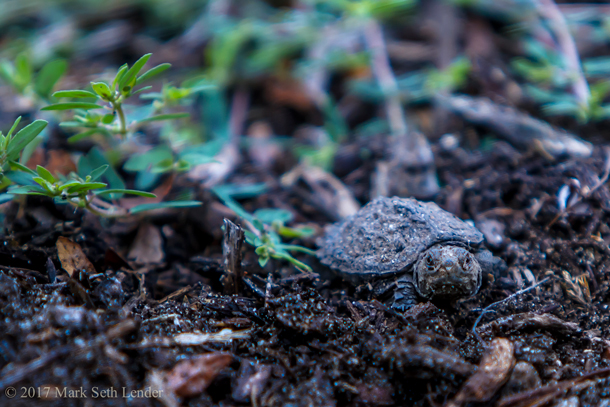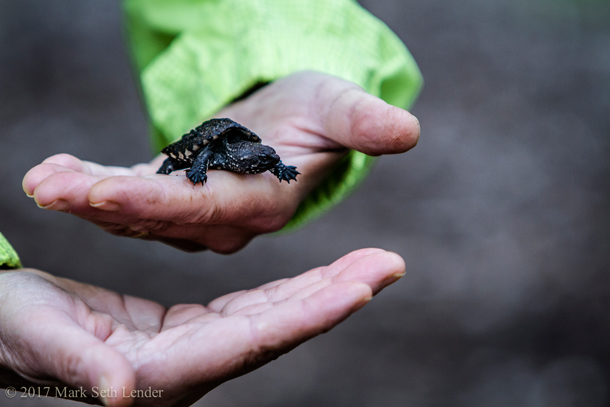Snapping Turtle: Mark Seth Lender
Air Date: Week of December 29, 2017

Baby snapping turtles push towards Waterhouse Brook. (Photo: Mark Seth Lender)
Living on Earth's Resident Explorer Mark Seth Lender sometimes explores his own corner of Connecticut. Walking on the bank of the Waterhouse Brook, he happened by the nest of a Snapping Turtle, just as the hatchlings were scrambling out of the soft soil to face the perils and opportunities of life.
Transcript
CURWOOD: We stick with turtles – but a different species this time, observed by our resident explorer Mark Seth Lender. He often explores the river bank near his home in Connecticut where a snapping turtle has nested.
Snapping Turtle
© 2017 Mark Seth Lender
When the eggs were buried here above the stream, a milk snake came, black and agile and nosing into the earth that was softened by the digging out and hiding in. And took one. And then another one. And went away. Whether replete, or because his meal was disturbed, by being seen, impossible to determine.
Now, you would never know any of this. Or that anything lies there under the ground, waiting.

A snapping turtle explores the edge of the nest. (Photo: Mark Seth Lender)
It all looks the same across to the other bank. Or downstream. Or upstream. There remains no marker of where the snapping turtle climbed up, laborious and slow, undeterred by the angle of ascent, up between the rocks, the wet dirt spangled in vines and weeds. It was too long ago. Weeks, months in fact. The signs washed away in the rain. She scraped out her nest, the ancient claws working, working, the soft opalescent ovals dropped in a pattern one by one. Not too close. Each the right way up so the life inside, sleeping, eyes closed, would not drown in the long waiting to be born. She covered them and slipped and slid her way back to the stream that seemed then as now, much too shallow for the armored bulk of her shell, the flattened head, the toothless jaw like a bolt cutter and just as strong as that though made of blood and bone. She never came back. The Earth alone will be mother to what comes next:
The rotten branches and the leaf litter ground small by season and time are shivering.
The once and future place is trembling and rising and sinking.
Heaving.
Its surface breaking: Out of the ground that is quaking and roiling an army moves into the day light.
Forest adheres to the nascent shells, the hatchlings wet from birthing, their nostrils plugged with soil driven in by the force of climbing out. They come one on another fast, out of fear. But the only watcher will not harm them except to lift one into the palm of a hand for the sake of seeing what is seen never, or seldom:

A baby snapping turtle in a human hand for scale. (Photo: Mark Seth Lender)
- The dark of the eye.
- Iris with its bright rim.
- Sharp claws, the tiny limbs.
A rough place, the navel on the underside of the carapace, the only mark that tells, “We like you were nourished before we were born in a tiny replica of ocean, that Ocean From Which All Life Comes.”
CURWOOD: That’s our explorer in residence, Mark Seth Lender – and there are pictures at our website, loe dot org.
Links
Living on Earth wants to hear from you!
Living on Earth
62 Calef Highway, Suite 212
Lee, NH 03861
Telephone: 617-287-4121
E-mail: comments@loe.org
Newsletter [Click here]
Donate to Living on Earth!
Living on Earth is an independent media program and relies entirely on contributions from listeners and institutions supporting public service. Please donate now to preserve an independent environmental voice.
NewsletterLiving on Earth offers a weekly delivery of the show's rundown to your mailbox. Sign up for our newsletter today!
 Sailors For The Sea: Be the change you want to sea.
Sailors For The Sea: Be the change you want to sea.
 The Grantham Foundation for the Protection of the Environment: Committed to protecting and improving the health of the global environment.
The Grantham Foundation for the Protection of the Environment: Committed to protecting and improving the health of the global environment.
 Contribute to Living on Earth and receive, as our gift to you, an archival print of one of Mark Seth Lender's extraordinary wildlife photographs. Follow the link to see Mark's current collection of photographs.
Contribute to Living on Earth and receive, as our gift to you, an archival print of one of Mark Seth Lender's extraordinary wildlife photographs. Follow the link to see Mark's current collection of photographs.
 Buy a signed copy of Mark Seth Lender's book Smeagull the Seagull & support Living on Earth
Buy a signed copy of Mark Seth Lender's book Smeagull the Seagull & support Living on Earth

